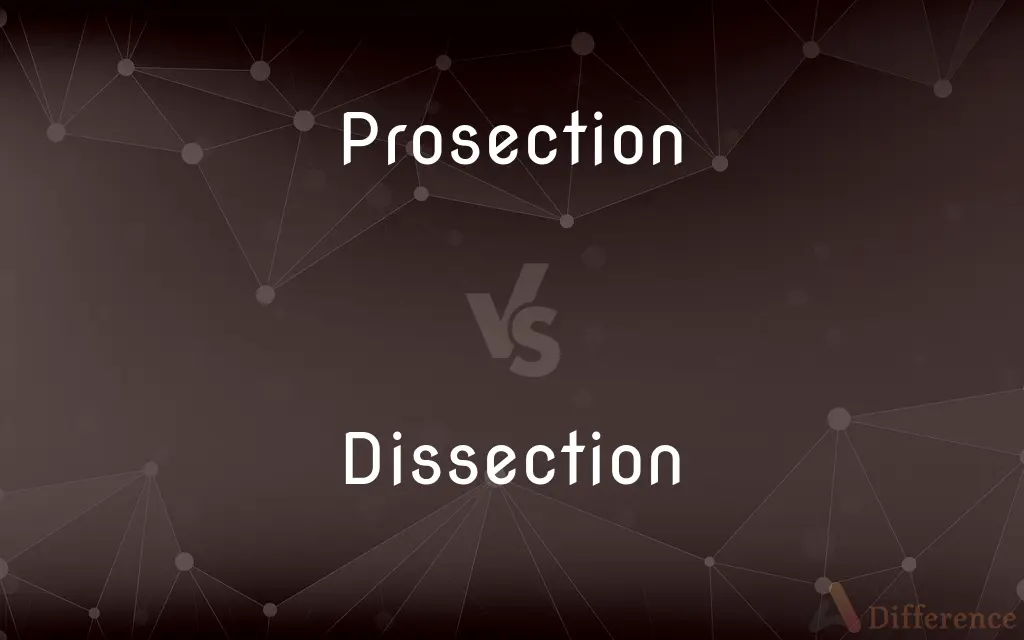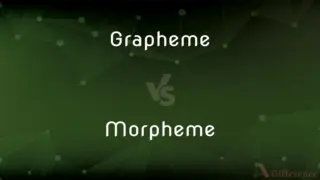Prosection vs. Dissection — What's the Difference?
By Tayyaba Rehman & Maham Liaqat — Updated on April 25, 2024
Prosection involves the preparation and display of anatomical structures for educational purposes, focusing on preserving details; dissection entails actively cutting and separating tissues to study their relationships and functions.

Difference Between Prosection and Dissection
Table of Contents
ADVERTISEMENT
Key Differences
Prosection is a preparatory technique used in medical and biological education to display specific anatomical structures in their preserved state, allowing for detailed observation and study. Whereas, dissection is an active process where students or researchers cut into and separate tissues to explore internal structures and understand their spatial relationships.
Prosections are often performed by experienced anatomists and are used as reference models in educational settings, providing a static and detailed view of complex anatomical regions. On the other hand, dissection offers a hands-on learning experience, encouraging a deeper understanding through exploration and manipulation of tissues.
In prosection, the aim is to maintain the integrity of anatomical features, enhancing learning through clear, undisturbed visualizations. Conversely, dissection often involves altering the original condition of the specimen, which can lead to loss of some anatomical details but provides practical insights into the assembly of biological systems.
Prosected specimens are typically used in demonstrations and lectures, where they serve as precise teaching aids for students to study without performing any cuts themselves. Dissection, however, requires the active involvement of students, making it a fundamental tool in active learning and critical thinking in fields like medicine and biology.
While prosections provide a static educational resource that can be used repeatedly, dissections allow for a dynamic educational process where each experience can be unique, depending on the specimen and the dissection technique used.
ADVERTISEMENT
Comparison Chart
Purpose
Demonstrates pre-prepared anatomical structures for study
Involves cutting into tissues to explore internal structures
Usage
Often used for detailed, static displays in education
Used for hands-on learning and exploration in education
Preparation
Performed by experts to maintain detail and structure
Performed by students or researchers, often altering the specimen
Educational Focus
Enhances visual learning through observation
Promotes interactive and practical learning
Outcome
Provides a consistent educational tool
Offers varied learning experiences based on individual dissection
Compare with Definitions
Prosection
A method in which anatomical structures are prepared and displayed for educational purposes.
The medical school displayed a prosection of the human heart in the anatomy lab.
Dissection
A hands-on technique for exploring biological systems.
During the dissection, students identified various organs within the abdominal cavity.
Prosection
The display of a meticulously prepared specimen for demonstration.
Students observed the detailed prosection of a brain during their neuroscience class.
Dissection
A method used to gain practical insights into anatomical relationships.
Through dissection, students understood the layout of the nervous system.
Prosection
A technique used to teach anatomy without alteration of the specimen.
The prosection allowed students to identify muscle attachments easily.
Dissection
The process of cutting into and separating tissues to study body structures.
The dissection of the frog helped students learn about amphibian anatomy.
Prosection
A static display that aids in the understanding of complex structures.
The prosection of the vascular system was key to understanding its intricacies.
Dissection
An educational practice in biology and medicine that involves altering specimens.
Dissection provided the first-hand experience of the mammalian circulatory system.
Prosection
A preserved educational tool in medical and scientific settings.
The prosected organs were used in a comparative anatomy lecture.
Dissection
An active learning tool that encourages critical thinking.
The dissection lab challenged students to identify anatomical features on their own.
Prosection
A prosection is the dissection of a cadaver (human or animal) or part of a cadaver by an experienced anatomist in order to demonstrate for students anatomic structure. In a dissection, students learn by doing; in a prosection, students learn by either observing a dissection being performed by an experienced anatomist or examining a specimen that has already been dissected by an experienced anatomist (etymology: Latin pro- "before" + sectio "a cutting")A prosection may also refer to the dissected cadaver or cadaver part which is then reassembled and provided to students for review.
Dissection
The act or an instance of dissecting.
Prosection
An anatomical dissection carried out by an experienced anatomist as a demonstration for others.
Dissection
Something that has been dissected, such as a tissue specimen under study.
Dissection
A detailed examination or analysis.
Dissection
The act of dissecting, or something dissected
Dissection
A minute and detailed examination or analysis
Dissection
(medicine) surgical removal
Neck dissection
Lymph node dissection
Dissection
The act of dissecting an animal or plant; as, dissection of the human body was held sacrilege till the time of Francis I.
Dissection
Fig.: The act of separating or dividing for the purpose of critical examination.
Dissection
Anything dissected; especially, some part, or the whole, of an animal or plant dissected so as to exhibit the structure; an anatomical so prepared.
Dissection
Cutting so as to separate into pieces
Dissection
A minute and critical analysis
Dissection
Detailed part-by-part critical analysis or examination as of a literary work
Common Curiosities
What is prosection?
Prosection is the preparation and display of anatomical structures for educational purposes, focusing on maintaining the integrity and detail of the specimen.
What is dissection?
Dissection involves cutting into and separating tissues to explore and study internal anatomical structures.
How do prosection and dissection differ in educational use?
Prosection serves as a static educational resource for observation, while dissection provides a dynamic, hands-on learning experience.
Can dissection and prosection be used together in educational settings?
Yes, both methods can be complementary, with prosections providing detailed reference models and dissections offering practical, explorative learning.
Are prosected specimens real human bodies?
Yes, prosected specimens are often real human bodies that have been donated for educational purposes and carefully prepared to demonstrate specific anatomical structures.
Why might an institution choose prosection over dissection?
Institutions might choose prosection to provide detailed, consistent anatomical demonstrations without the need for students to perform dissections, preserving the specimen for repeated use.
How long can a prosected specimen be used for educational purposes?
With proper preservation techniques, a prosected specimen can be used for many years as an educational tool.
What preservation methods are used in prosection?
Techniques like embalming, refrigeration, and plastination are commonly used to preserve specimens for prosection.
How do students typically react to their first dissection experience?
Reactions can vary widely, from excitement and curiosity about human anatomy to discomfort or ethical concerns about the use of real bodies in education.
What are the benefits of prosection in medical education?
Prosection allows students to observe perfectly preserved and detailed anatomical structures, enhancing visual learning and understanding.
What ethical considerations are associated with prosection and dissection?
Both practices require ethical consideration regarding the use of human and animal bodies, ensuring respect, consent, and appropriate use in educational contexts.
What skills does dissection help develop in students?
Dissection helps develop practical skills, critical thinking, and a deeper understanding of biological and anatomical relationships through hands-on experience.
How does dissection influence the understanding of disease processes?
Dissection allows students and researchers to directly observe and study the effects of diseases on the body, providing a practical context for theoretical knowledge.
Can digital tools replace the need for dissection and prosection?
While digital tools provide supplementary educational resources, they cannot fully replace the tactile and detailed insights offered by physical dissection and prosection.
Is dissection still relevant in modern medical training?
Yes, dissection remains a crucial component of modern medical training, providing irreplaceable insights into the tactile and spatial aspects of human anatomy.
Share Your Discovery

Previous Comparison
Wain vs. Wane
Next Comparison
Grapheme vs. MorphemeAuthor Spotlight
Written by
Tayyaba RehmanTayyaba Rehman is a distinguished writer, currently serving as a primary contributor to askdifference.com. As a researcher in semantics and etymology, Tayyaba's passion for the complexity of languages and their distinctions has found a perfect home on the platform. Tayyaba delves into the intricacies of language, distinguishing between commonly confused words and phrases, thereby providing clarity for readers worldwide.
Co-written by
Maham Liaqat













































